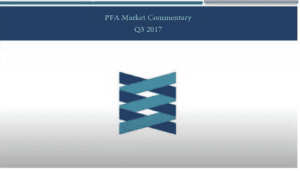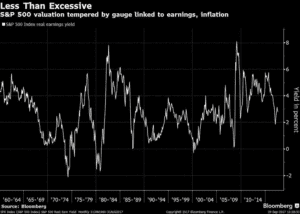Market Commentary – Q3 2017
 Global markets managed to shake off natural disasters and geopolitical sabre rattling, to post a third quarter with steady growth and low volatility. Generally, central bankers continued with relatively easy monetary policy, continuing to provide fuel for one of the longest global market expansions in history.
Global markets managed to shake off natural disasters and geopolitical sabre rattling, to post a third quarter with steady growth and low volatility. Generally, central bankers continued with relatively easy monetary policy, continuing to provide fuel for one of the longest global market expansions in history.
Domestically, the S&P 500 gained 3.9%, bringing the 2017 return up to 12.5% year-to-date. Technology and Healthcare stocks led the way, but gains were broad-based, with 11 out of 12 industry sectors gaining. Only consumer staples lagged, shedding 2% on the quarter. Stocks of smaller companies outpaced those of their larger peers during the quarter, making up some of the ground they had lost by lagging in the first two quarters.
The news has been even better for international stocks. The MSCI EAFE ex-US (a broad index of non-US companies) has posted 16.5% gains year-to-date and the MSCI Emerging Markets index is currently up over 28% on the year. Poland seems to have led the pack, with two Polish Stock Exchange Traded Funds up over 50% on the year.
Fixed income markets have also remained relatively quiet. The Fed has continued to raise rates at a very cautious pace, but still targets a 2.75% fed funds rate in the long term. The Fed has also started to become net sellers, rather than net buyers, of treasuries and mortgage-backed securities. This balance sheet reduction will likely put upward pressure on yields. Spreads on high yield bonds have fallen slightly below their long-term average, but given a current default rate of 1.1% versus a long-term default rate of 3.9%, lower spreads can certainly find justification.
A weakening dollar relative to the Euro, the Pound, the Canadian Dollar and the Aussie Dollar further bolstered the outperformance of invested assets in these areas, in
US Dollar terms. Economic growth accelerated throughout the quarter, but it hits resistance at a real GDP growth rate of about 2%. It seems unlikely that the growth rate will improve dramatically in the foreseeable future. If we segregate real GDP growth into two basic components: growth in the size of the workforce (age 16-64) and growth in the productivity of that workforce, we find productivity growth trending below historical averages and workforce population increasing at the lowest level in history. Only about .3% annual growth is anticipated in the US population age 16-64 over the next decade. Interestingly 85% of that population is expected to have been born outside the US
Despite these more fundamental headwinds, we are cautiously optimistic about US equity markets in the near term. Corporate earnings growth, coupled with inflation-adjusted earnings yields that are solidly within historical bounds (see chart) give us comfort. That said, we continue to favor a small over-weighting in European markets (who have further to advance in improving employment figures) and Emerging Markets (where better growth and more attractive valuations continue to provide tail winds). In the fixed income markets, we continue to be cautious of duration risk, preferring to seek yield with shorter maturities and lower credit qualities. Despite headline issues in places like Puerto Rico and Detroit, Municipal bonds continue to be attractive providing yields at almost 90% of those of their taxable counterparts.

Chart courtesy of Dave Wilson, Bloomberg News
Penobscot Financial Advisors is a registered investment advisor. Past performance is no guarantee of future returns. Investing involves risk and possible loss of principal capital.



